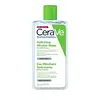What's inside
What's inside
 Key Ingredients
Key Ingredients

No key ingredients
 Benefits
Benefits

No benefits
 Ingredients Side-by-side
Ingredients Side-by-side

Water
Skin ConditioningPropanediol
SolventPEG-6 Caprylic/Capric Glycerides
EmulsifyingGlycerin
Humectant1,2-Hexanediol
Skin ConditioningCaprylhydroxamic Acid
Niacinamide
SmoothingBiosaccharide Gum-1
HumectantGlucamine
HumectantSodium Hyaluronate
HumectantSodium Lauroyl Lactylate
EmulsifyingRhamnose
HumectantGlucose
HumectantGlucuronic Acid
BufferingCeramide NP
Skin ConditioningCeramide AP
Skin ConditioningPhytosphingosine
Skin ConditioningCholesterol
EmollientXanthan Gum
EmulsifyingCarbomer
Emulsion StabilisingCeramide EOP
Skin ConditioningWater, Propanediol, PEG-6 Caprylic/Capric Glycerides, Glycerin, 1,2-Hexanediol, Caprylhydroxamic Acid, Niacinamide, Biosaccharide Gum-1, Glucamine, Sodium Hyaluronate, Sodium Lauroyl Lactylate, Rhamnose, Glucose, Glucuronic Acid, Ceramide NP, Ceramide AP, Phytosphingosine, Cholesterol, Xanthan Gum, Carbomer, Ceramide EOP